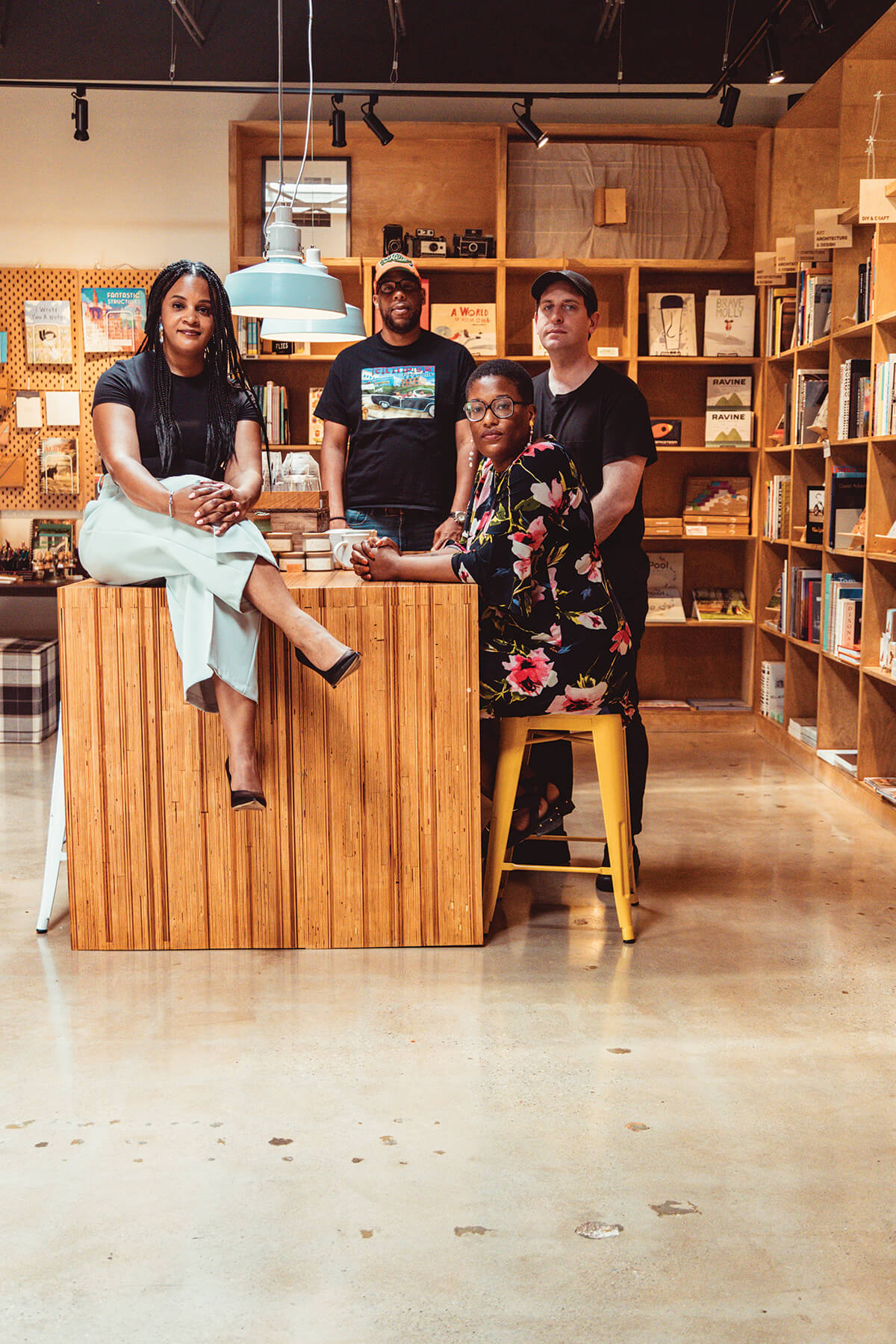
Baltimore isn’t getting one additional news outlet this summer, it’s getting two.
The Baltimore Beat, which had emerged after The Baltimore Sun bought and then shuttered the former alt-weekly City Paper, is re-launching this July as a bi-monthly, Black-led print newspaper and website.
Initial funding for the re-launch came from a $1 million gift from the Baltimore-based Lillian Holofcener Charitable Foundation. Baltimore’s other coming-soon outlet, The Baltimore Banner, will be a daily news site that is expected to rival The Baltimore Sun with a promise of $50 million in startup money from founder Stewart Bainum and other investors.
The Beat, which launched in print in 2017 and ultimately ceased operating as a digital outlet in 2020, is being led by its original editor-in-chief, Lisa Snowden-McCray, and two other Baltimore-based Black journalists. Previously, Snowden-McCray served as editor at City Paper, The Sun, and most recently, The Real News Network. J. Brian Charles, a veteran journalist based in Baltimore for the last several years with more than 16 years of experience covering race, class, education, housing, politics, and criminal justice issues, will serve as deputy news editor. Charles’ work for The Trace, a national website dedicated to gun violence reporting, earned an ASME finalist nod for Special Interest coverage last year. Teri Henderson, most recently a staff writer and gallery coordinator for the well-regarded local arts journal, BmoreArt, will serve as arts and culture editor. She is also the author of the 2021 book, Black Collagists.
Former Baltimore City Paper editor-in-chief Brandon Soderberg will serve as director of operations for The Beat. He is also the co-author of the book, I Got A Monster: The Rise and Fall of America’s Most Corrupt Police Squad, about the city’s infamous Gun Trace Task Force.
The fulltime staff will be those four initially, however, a photo editor is expected to be added soon. Snowden-McCray says that, much like the City Paper, The Beat will have a substantial freelance budget, and report across much of the same terrain—arts and music, food, politics, policing, criminal justice, education, the environment, and housing—covering not just the city’s struggles, but celebrating Baltimore’s neighborhood life and thriving culture.
The website will also include outside op-eds and commentary, as well as editorials from the staff. The generous contribution from the Lillian Holofcener Charitable Foundation has enabled a full year of planning and has already helped spark other philanthropic investment in the paper. The idea, Snowden-McCray and Soderberg say, is to build slowly and sustainably—eventually growing into a weekly publication—in part to avoid burnout from the relatively small crew.
Snowden-McCray says she’s been inspired by what the digital-only, but similarly sized Baltimore Brew has been able to accomplish in their work covering local government. She’s also been inspired by the long history, creativity, and against-the-odds success of The Afro in Baltimore.
“This has really been a growing process, and learning a lot about media, including my failures,” Snowden-McCray says of the now years-long effort of trying to successfully recreate a version of the City Paper, Baltimore’s widely respected and long-beloved alternative newspaper. “One of things I’ve learned in my journey is keeping things as simple as possible, and boiling things down to the essentials, and I’ve taken the best parts of the City Paper with me.
“I think what made the City Paper essential was covering arts and culture, food, and the deeply reported stories about politics. Figuring out the best way our team can do it [is the challenge]. We may not be able to cover everything, right away, but what we do cover, we want to do really well.”
In the alt-weekly tradition, Charles says the mission is to focus on people and communities, rather than institutions, in their stories and longer-form narratives.
“We’re going to try to get outside of saying, ‘Hey, it’s important for us to cover City Hall,’” Charles said in a recent Zoom interview from the Baltimore Beat’s offices at the Co-Lab Workspace in Remington. “That is important. But we want to get into peoples’ neighborhoods and communities, and have the people in those communities be the primary drivers of what we’re talking about and how we tell stories. Rather than tell a story about housing through the lens of how City Hall is dealing with an issue, we need to tell stories about how Baltimore City residents are grappling with [a housing issue] and the city’s response to it.”
Henderson says she hopes to push the boundaries of arts coverage, decoupling it from historically largely white-led and white funded institutions in Baltimore.
“BmoreArt’s primary [subscription print] audience is older white ladies who have the means to pay for an art publication that comes out twice a year,” she says. “My goal with the Baltimore Beat, which I did with BmoreArt, with a project on DJ’s, for example, is to uplift and make room for Black, Brown, and queer creatives who are often ignored by the predominately white art world.” She also emphasizes the need for multiple journalists, perspectives, and spaces covering Baltimore’s diverse arts scene.
Snowden-McCray, Charles, and Henderson all stress that they don’t view arts and culture as a separate mission from their other news reporting, but part and parcel of covering the whole of city life. What is distinct, however, from the former City Paper, Sun, or Banner is the Beat’s mission to directly serve Baltimore’s Black majority community.
“This is a Black newspaper,” Snowden-McCray says. “I know we have Black newspapers here, like The Afro, but it does Black people a disservice to say we only get a few. The more that there are, the better. Black people are not a monolith, so we provide another perspective, and we provide another opportunity for Black journalists to work.”
Another goal is eventually mentoring young Black journalists, ideally through formal paid internships down the line, but also by simply offering an outlet to report and write in the near term. “It’s as important to create a lane for young Black journalists as it is to do the work,” Snowden-McCray says.
Eventually, the bi-monthly print version of The Beat, at an estimated 20 pages to start this summer, will be placed in 50-100 boxes, largely situated in the city’s majority Black communities. The content will also be shared on the Beat’s website. The protype box is still being worked out, and Soderberg says that the hope is that the boxes will also serve a utilitarian purpose, supplying needed gloves and hats in the winter, and possibly free first aid, toiletries, and the opioid-overdose antidote, naloxone.
“It’s really important to me that everything we do is community focused,” Soderberg says. “Not only that we are a community focused newspaper, but we deliver real material assistance to people, as well. We want to walk the walk in that way.”
When speaking to the importance of producing a print publication, Snowden-McCray says that’s always been a non-negotiable part of the re-launch, given the lack of access to the internet in many parts of the city and many households. There will not be a paywall to the website, either, out of similar equity concerns.
“Upwards of 40 percent of the city’s households do not have a broadband connection, and up to 75,000 households don’t have a desktop or laptop computer,” Charles notes. “There’s a large audience there, too.”
The startup funding for the new Beat is an unusual story itself. The Lillian Holofcener Charitable Foundation, which had about $1 million in total in its fund, generally giving out $8,000 to $10,000 each year in grants, initially approached Soderberg and McCray after the death of George Floyd. The family, including local nonprofit lawyer Adam Holofcener, had been fans of both the City Paper and The Beat, and discussions about retooling The Beat began in earnest in the fall of 2020.
“The idea is this is a white foundation, a white family who made their money in East Baltimore, locating a way to support Black Baltimore,” Soderberg says. It’s worth highlighting that there are no strings attached to funds, Soderberg adds, and that the funding “is not coming out in drips, which you often see, but which causes organizations harm because it inhibits them from growing. This money gave us a year of planning and then about a year of [operating] budget. We’ve since raised enough that we now have funding for an [operating] budget of a year and a half.” The Beat has been set up as its own nonprofit, with its own nonprofit board.
Ongoing support will need to come from other philanthropic organizations, as well as contributions from the public and local readers who deem the project worthwhile. Whether The Beat can generate sustainable annual budgets from those contributions, and for how long, is of course the major question—as it is for an increasing number of new, nonprofit local journalism outlets in the city, state, and around the country. But they do have a running start.
“We were interested in making a grant, an amount of capital, to give them time to prepare, and to also hire more and better people than they would have otherwise,” says Adam Holofcener, of the decision to empty his family foundation’s coffers to re-launch The Beat. “It was also important to us that as a white, Jewish family, that we participate in the divestiture of the power that comes with this kind of money. We wanted to divest ourselves, our family, from the privilege that typically further dictates policy [in this case, of a media outlet].
“Funders make policies in city government, in terms of the development, whether it’s commercial real estate, the creation of jobs, or the creation of culture,” Holofcener continues. “And so it was just as important to divest—to take some of that power away from ourselves—and return that power to the community.”
